|
 Gliophorus versicolor Gliophorus versicolor
SynonymsHygrocybe versicolor
BiostatusPresent in region - Indigenous. Endemic
Images (click to enlarge)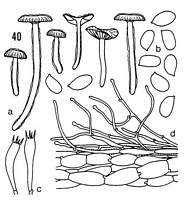
Caption: Gliophorus versicolor Hk. (type): a. carpophores. - h. spores. - c. basidia. - d. cuticle | 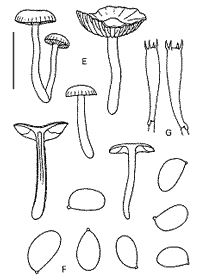
Caption: Fig. 28 Gliophorus versicolor Horak (E-G: PDD 27095, type): E.
basidiomes. F. spores. G. basidia | 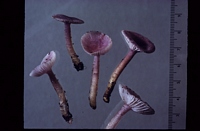
Owner: Herb. PDD | 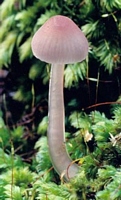
Caption: Gliophorus versicolor
Owner: Kaimai Bush | 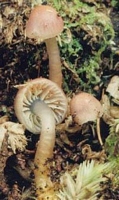
Caption: Gliophorus versicolor
Owner: Kaimai Bush | 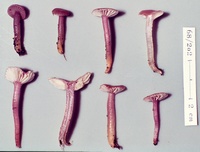
Caption: ZT68-202 , Holotype
Owner: E. Horak: © Creative Commons Attribution-Noncommercial 3.0 New Zealand | 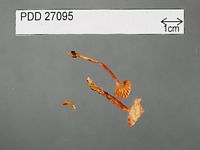
Caption: Dried type specimen
Owner: Herb PDD |
Article: Horak, E. (1990). Monograph of the New Zealand Hygrophoraceae (Agaricales). New Zealand Journal of Botany 28(3): 255-306 (http://www.rsnz.org/publish/abstracts.php).
Description: Pileus -20 (-50) mm, hemispherical then convex to plano-convex or subdepressed
at centre (with upturned margin); reddish brown, liver brown or lilac-pink,
fading towards strongly striate margin; glutinous when moist, glabrous in dry
condition, membranaceous. - Lamellae broadly adnate to subdecurrent, distant;
whitish or concolorous with pileus, occasionally grey-lilac, edges entire, concolorous,
occasionally gelatinised. - Stipe 20-70 x 1.5-3 mm, cylindrical, equal or rarely
attenuated towards base; grey, pinkish brown or lilac above, ochraceous or whitish
at base, glutinous, hollow, single or caespitose. - Odour and taste not distinctive
or slightly unpleasant, like burnt hair. - Chemical reactions on pileus: KOH
- pale yellow; HCI, NH3 - negative.
Spores 5.5-7 x 3.5-4 um, ovoid. - Basidia 24- 30 x 5-7 um, 4-spored. - Cystidia
absent -Pileipellis an ixocutis of erect, cylindrical hyphae (3- 8 um diam.),
with branched or subcapitate terminal cells, membranes strongly gelatinised,
with plasmatic pigment; clamp connections present (Pl. 1, Fig. 6).
Habitat: ECOLOGY: Scattered; saprobic on soil among litter under Dacrycarpus
and Nothofagus. March.
Distribution: DISTRIBUTION: NZ (WL).
Article: Horak, E. (1973). Fungi Agaricini Novazelandiae I-V. Beihefte zur Nova Hedwigia 43: 200 p.
Description: Pileus 5-20(-25) mm diam., hemispherical when young then convex to plano-convex or centre of pileus subdepressed and margin upturned, reddish-brown liver brown or lilac-pink, fading towards the strongly striated margin, glutinous, glabrous, membranaceous. Lamellae broadly adnate to subdecurrent, whitish or concolorous with pileus, occasionally grey-lilac, distant, gill edge even, concolorous, gelatinized at times. Stipe 20-70 x 1.5-3 mm, cylindric, equal, rarely attenuated towards the base, grey, pinkish-brown or lilac above, ochraceous or whitish at the base, glutinous, hollow, single and in clusters. Context waxy, on drying reddish to pink. Taste and odor absent or slightly like burnt hair. Chemical reactions on pileus: KOH - yellowish, HCl and NH3 - negative.
Spores 5.5-7 x 3.5-4 µm, ovoid, smooth, inamyloid. Basidia 24-30 x 5-7 µm, 4-spored. Cystidia absent. Cuticle an ixotrichoderm consisting of erect, strongly gelatinized, cylindric hyphae (1-4 µm diam.), terminal cells branched, occasionally subcapitate. Clamp connections on septae.
Habitat: Amongst litter under Nothofagus (N. fusca, N. cliffortioides), Podocarpus, Dacrydium, Quintinia, etc. New Zealand.
Notes: For discussion see G. lilacinoides Hk. (38).
|